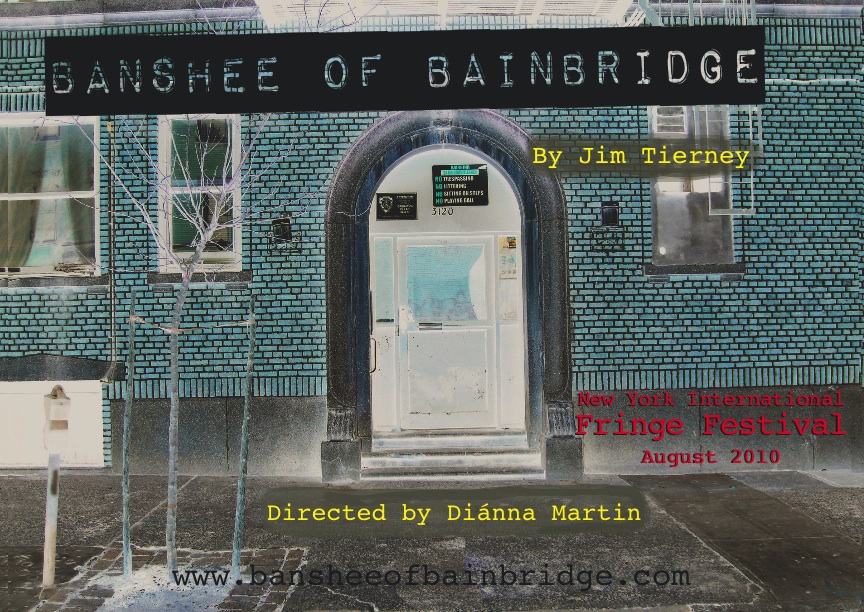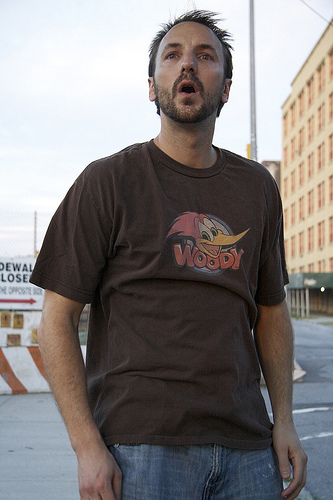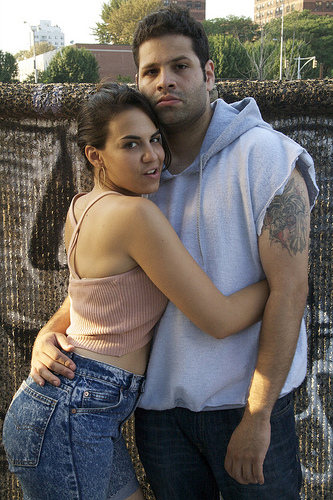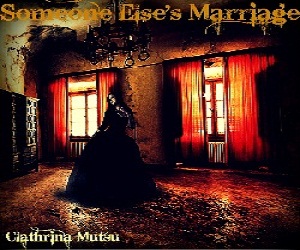
We’re very lucky here, at The Happiest Medium, to have such talented contributors. Our very own Diánna Martin is on a roll – having just directed Good Lonely People for The Planet Connections Festivity she now is working with Jim Tierney’s gritty, gripping play, Banshee of Bainbridge, which will be part of this year’s Fringe Festival. I was lucky enough to read this script and can only say that I was amazed – and can’t wait to see the show come to life.
I got a chance to find out a little bit more about what it feels like to be a part of Fringe, what Banshees are doing in the Bronx, and why the 1980s made for a lot of waiting around . . .
Congratulations on getting Banshee of Bainbridge into Fringe! What does it mean to you to be involved in this important Festival?
JIM: I’ve tried to get some of my work in the Fringe some years ago, but it wasn’t the right time for me. I think I was still trying to find my voice. So when I submitted Banshee of Bainbridge I wasn’t holding my breath. Obviously it’s a wonderful opportunity for a new playwright to get his or her work seen, but what’s great about the Fringe is that it’s going to have the opportunity to reach audiences that I wouldn’t necessarily have access to otherwise. I forget sometimes writing it is only half the battle and a brutal one at that. Having people listen to your words as you envisioned them is like nothing else, and so I’m thrilled that I get to have that experience this summer. That and it’s kind of one of them things that sits over your head. Any self produced playwright wants to eventually do the Fringe.
DIÁNNA: Thank you! I’m so delighted to be directing this play for Fringe because Fringe has become a staple of the theatrical community that lets a lot of wonderful theatre get produced, and hopefully because of the rich audience base, a lot of people will come see this play. I support it so much, and I’m so thrilled to be directing it because it’s one of the best plays I’ve read in years. It’s such an intense, dark character study…and it allows me to work with such talented actors and help bring out the rich characters within this shocking, funny, tragic piece. It pushes the envelope and doesn’t pull any punches.
Jim, tell our readers what inspired the title of your play.
JT: The story came to me about four years ago. It started with this image of a grown man lifting weights to Barbara Streisand, it was the 1980’s and ironically…taking place inside the room I grew up in. I would toy around with certain types of music that would stir up an emotional response and Barbara, for me, is known for that, as it reminds me of my mother singing to her records back in the day. I really wanted to find a child-like character that wanted to be a hero for a world that wasn’t asking for one. The idea that through persistence, this nobody, was going to change the way things were fascinated me. At that time it was called “Super”. So I wrote a thirty or so page story on that, with full intention of turning it into a screenplay. It took me three years to materialize the screenplay, and it was when the protagonist starts to get hung up on banshees that I realized it should be called Banshee of Bainbridge. Because the character lives on Bainbridge Avenue in the Bronx.
Considering the constraints of timing for setup and scheduling that one often has for Fringe how did you deal with the challenges of costuming and special effects for Banshee of Bainbridge?
DM: Well, the play was set up already to have a very minimal set – just chairs, actors, and a few props, etc. That was given to me and was one of the things that was exciting and challenging to me as a director. When you strip away big sets, etc – and are left with just damn good acting, that’s where the meat and potatoes are for me (in all due respect to the brilliant set designers I love out there). So the set was minimal; but then yes, the time constraints offered a challenge in regards to lighting, sound, and costume…but that was achieved because we have brilliant designers. I had ideas that I brought to the table and they did as well…and then they found ways to incorporate them into the show (and set up in like 10 minutes) and have it still WORK. I truly believe it works, and I hope the audience does as well. The lights and music for many monologue aspects help us get into the mind of this man…and for costumes, we have several characters playing multiple roles, and so for me a costume would simply be throwing an apron on or a hat or glasses – which was then taken further by our costume designer. But the actors are on stage almost the whole show, so it had to be small changes – and I think we’ve succeeded.
Do you see The Banshee of Bainbridge as a solo show with a strong supporting cast or a normal ensemble piece with a a strong central character?

Mij
JT: I see it as an ensemble piece with a strong central character. Without the other characters, you wouldn’t get a sense of Mij’s world. You would only hear about it through his monologues. At lease with characters from the neighborhood coming in and out of the play you get a chance to see Mij’s uncomfortable association with the world around him. That helps alienate the character.
DM: Haha – well, that’s a good question. At times I refer to it as a solo show that then tells the tale with scenes carried out by the strong ensemble – and other times I say that it’s a play that is really all about all of the characters in the show – for they are all ghosts of this man’s life. To be honest, I love the monologues and the storytelling behind it (and Michael W.’s fantastic work, of course) – but it would not be the same without the incredible characters played by an amazing and incredibly talented cast that we get to see enmeshed in the telling within the scenes. The ensemble – and this is one of the strongest ensembles I’ve ever worked with either as an actress or director – brings so much together as a whole.
Diánna, does the structure of Banshee of Bainbridge give you some unique opportunities as a director?
It totally does. It allows me to tell a tale that forces the audience to go along on a ride of the imagination. It allows me to work with actors in such a way that we create entire locations and sets with just the reality that they bring to it. It allows me to do to different kinds of plays and then combine them into this unique tale. I get to work with one actor in the almost “One-Man-Show” aspect, like we mentioned earlier, which is a delight for me because I love working on monologues with actors. But to then to work on such a character as Mij, this dark and damaged individual, who we also root for and feel so sorry for, despite the things he does – to work a 180 degree turn on the audience like that whets my appetite. But that’s just one course. Because then I have these incredible scenes as well – with characters, who, although they may not have much stage time at each instance, are so strong that they are indelible to the mind whether they are hilarious or disliked. And within these scenes I have been able to use the same actors in multiple roles because of the versatility of the actors – and the writing.
I think that this play is so psychological; we see a breakdown of people in general from Mij’s perspective, that casting the roles and having the actors play different characters for the most part is another element to how the audience can see how he breaks down people into categories. To have a story told to us and then see what happened in the way that we do is wonderful.
Banshee of Bainbridge is a historical play set in the East Bronx in 1985. Did you write this more as a story to help us remember a past we should be happy to have escaped, or one with valuable lessons for the future?
JT: I think it’s a little bit of both. First off, I set it in that time period, because I grew up in that neighborhood at that time and drew from things I remember hearing and seeing. I had some older cousins that still tell me stories to this day that I don’t remember, so it’s not necessarily everyone’s version of Bainbridge Avenue in 1985, but rather what a damaged child like man experiences. Also, I wanted to place the story in a world that knew nothing about computers or CGI or advanced video games. There was this comic book shop that we had down the street and I liked playing with the idea that back then we still had to use our imagination. This is why I find myself writing a lot of pieces about the 80’s. Maybe it’s because I’m just really uncomfortable with how we have all become so dependent on knowing everything at all times and getting that information as fast as we can. Things were slower in the mid to late 80’s. Significantly slower to the point where it was harder to escape into a movie on your cell phone. I just remember a lot of waiting around and figuring out ways to keep myself busy with what was in front of me. I liked that about the play.
But I also think it’s about learning from our mistakes. Really, it’s about how one is a product of his environment, in relation to Mij’s upbringing. You see Mij is dependent on his mother to the point of becoming a burden to society. When his mother dies at the top of the play, he becomes everyone’s problem. When I got out of high school, I remember not fitting in anywhere. It was a freaky time, because you were amongst adults and youths alike and had to find a way to co-exist with all types of structures and rules and it scared the hell out of me. So in a lot of ways, Mij sees the outside world as a threat. A jungle that is looking to eat him alive.

Rose and Carlos
Jim, you don’t shy away from racial and ethnic tension in Banshee of Bainbridge … How have you taken special care to make sure the deeper messages of the play have been emphasized?
JT: I wanted to display characters that would talk and react in ways that were real and truthful. A lot of racist people out there and it’s coming from every direction. What I wanted to play with is the things that make that racism come out. For one character it’s because he’s felt rejected by them, for another it’s because he’s different, and for the protagonist, it’s because he’s always known that from his upbringing. He’s convinced that Puerto Ricans are bad because he’s heard it all his life. In this play its common language. The characters use it in a way that simply identifies tribes if you will. I keep in mind the idea of a jungle. An overcrowded, hot uncomfortable jungle. Where the tension is high and yet it seems like no light is shined on it, in terms of hope. It’s a train wreck of an existence.
DM: If I may, I’d like to mention that I think the racial and ethnic tension of Banshee is really important…because it’s real. Everything that happens in this play happened in real life, one way or another – regardless of the biographical standpoint for Jim. I grew up in New York City in the 80′s, and I think that anyone can see this and walk away with their own feelings about how the tension has been portrayed, but I am half Puerto Rican and half English/Irish…and I was in this city back then…and it’s a truth of New York that a section that was all Irish became something totally different in the 80′s and never returned. The same can be said for so many neighborhoods all over for various ethnicities.
But all of that aside – what we see is a damaged, lost, individual who is trying to make his way through the maze of the world and deal with the world on its terms, not his; and his terms were always sheltered and distorted. Take sheltered, distorted, and abused, and drop it in the middle of New York City 80′s Bronx and you have a strong story no matter what you do. It just so happens that Jim is a brilliant playwright.
What’s the one thing you’d like to leave The Happiest Medium readers with about Banshee of Bainbridge?
JT: That we are a product of our environment. The ugly sides to people come from some place. That’s not to say their behavior is acceptable, but I wanted to show the ugly side to a person that is damaged. Not evil. A play by play of how a guy like this gets to a place like that. I don’t know if that answers your question but it’s the best I can do for now.
DM: I want audiences to be haunted. I want them to experience the strange sensation of feeling so sorry for this man but yet recognizing him as someone that if they heard him talking about the things he talks about they would either call him insane, racist, or have him arrested. I want them to see the dichotomy of who he is and then take the audience on a journey to experience a range of emotions and feelings about him and the characters he came into contact with. I want them to experience his sense of loss and his joys while wondering who they know might be like him. Oh, but you asked for one…
So, I guess haunted would be it.



{ 0 comments… add one now }
{ 1 trackback }